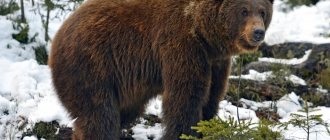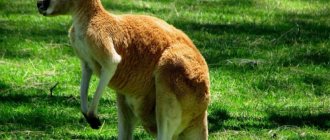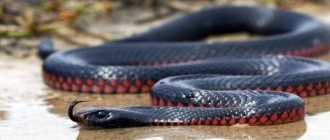What is the difference between a hippopotamus and a hippopotamus?
Many people living on earth do not know that these two words mean one animal belonging to the genus Artiodactyla.
The Latin name, taken from the ancient Greek language, the word Hippopotamus, literally means “river horse”. The Greeks gave this name to a huge beast that lives in bodies of water and is capable of making certain sounds, very similar to the neighing of a horse.
In the CIS countries, as well as in Russia, the hippopotamus is usually called a hippopotamus, which is rooted in biblical stories. In the book of Job, this is what they call a monster - one who embodies carnal desires.But in fact, hippopotamus and hippopotamus are the same animal.
Initially, the pig was considered a close relative of the hippopotamus, but scientists conducted research and in 2007 it became known that the hippopotamus has more in common with whales. These general signs are:
- the ability to give birth and feed newborns underwater
- complete absence of sebaceous glands
- the presence of a signaling system for communication between individuals
- structure of reproductive organs
Description and features
The ancients called this representative of the fauna a hippopotamus, that is, a “river horse.” It seems that in ancient times people sincerely believed that horses and hippos were related creatures. But biologists, much later systematizing the animal world of the planet, classified such creatures into the suborder Porciniformes, believing that their appearance and internal structure are fully consistent with this classification.
However, after conducting DNA research, scientists discovered that hippos are even more closely related to whales. For the uninitiated, this seemed unexpected, almost fantastic, but not without reason.
Yes, this creature, an inhabitant of hot Africa, can surprise you with many things. And above all, by its size, since it is one of the largest among the representatives of terrestrial fauna. The weight of a hippopotamus can reach 4.5 tons. This is not uncommon in nature, although not all such animals have the indicated body weight.
On average, in young individuals it is only 1500 kg, because it accumulates throughout life, that is, the older the animal, the more massive it is. The height of an adult individual is over one and a half meters. The length is not less than three meters, but can be more than 5 m.
Some scientists consider whales to be the hippopotamus's closest relatives
The mouth of these creatures is also impressive, which when open represents an unfolded angle, and its size from edge to edge is one and a half meters. When a hippopotamus opens its mouth, it inevitably becomes scary. And not without reason, because with his strong and unusually hard teeth he is able to bite through the backbone of a crocodile. And this, by the way, often happens.
The mouth of a hippopotamus when open is more than one meter
What is also noteworthy about the hippopotamus is its incredibly thick skin, sometimes weighing up to 500 kg. Its color is brown-gray with a pinkish tint. She is almost completely naked. And only short, coarse and sparse bristles, similar to a pig’s, cover some parts of the ears and tail, and on the muzzle there are numerous hard vibrissae.
The thickness of the skin can reach up to 4 cm. However, the skin, being not protected by natural vegetation, is not able to protect its owners from the merciless attacks of the African heat.
Under the influence of intense radiation, the animal's skin burns and becomes reddish in color. But as protection from the harsh sun, as well as from harmful midges, the body begins to sweat intensely, that is, to secrete a very unusual mucus. The sweat of such representatives of the animal kingdom also has a red tint.
And such a feature at one time gave food for the imagination of the creators of the famous Soviet cartoon, who took it upon themselves to assume that the hippopotamus , the hero of their plot, feels shame for his unseemly actions, and that’s why he blushes.
The skin of these creatures is also capable of secreting very useful enzymes that quickly heal wounds, of which this ever-warlike animal receives many during its life. But what the described African beast is not able to surprise is its beauty, elegance and grace.
And you can easily verify this by looking at the photo of a hippopotamus . Its head is massive (reaches a weight of up to 900 kg), on the side it has the shape of a rectangle, and in front it is significantly blunted. And in combination with disproportionately small ears, small eyes with fleshy eyelids, impressive nostrils, a terrifyingly huge mouth and an unusually short neck, it does not please the eye with the aesthetics of its lines.
In addition, the animal’s body is bag-shaped and barrel-shaped, moreover, it is supported on a thick sheath, which is so unnaturally short that a well-fed hippopotamus with a saggy belly moves, dragging its stomach almost on the ground. But the animal’s tail, short, but thick and round at the base, can surprise, although not entirely pleasantly.
At appropriate moments, it is used by the owner to spray urine and droppings over considerable distances. This is how hippos mark their areas, and the smell of secretions gives relatives very valuable information about a particular individual, which facilitates their communication.
What do hippos eat?
Hippos are considered to be herbivores and harmless animals. But recent studies have proven that certain individuals are prone to exhibiting the habits of a predator.
Due to a lack of minerals and salts, hippos are forced to attack gazelles, cows and antelopes, and are also able to feed on carrion.
Enemies
In their natural habitat, hippos have very few enemies. If we exclude humans, then only lions and crocodiles will remain.
Over time, when the males grow up, even these predators cease to be a threat to them. This even applies to flocks, because hippos live in herds, which makes it difficult to attack a solitary animal.
Moreover, crocodiles have no natural enemies other than hippos. An adult male is able to bite a large crocodile.
That's why they protect the herd.
Are hippos herd animals?
Hippos are social animals and gather in herds of 30-35 individuals. In some cases, the herd can reach 200 heads. The head of the herd is the alpha male, who constantly proves that he has the right to be first.
When fighting for a certain female, very brutal fights can take place between animals, as a result of which one of the opponents dies due to lacerations inflicted by fangs.
This is what characterizes the skin of a hippopotamus, covered with wounds and scars of varying degrees of freshness.
But keeping a herd is only the prerogative of an ordinary hippopotamus. Dwarf hippos try to stay alone, do not have such aggression towards their companions and do not try to protect their possessions.
Due to their large size, hippos are forced to live near bodies of water so that their skin does not crack and water does not evaporate from the body so quickly. They come ashore only at night to search for food.
Most often, hippos inhabit fresh water bodies; very rarely you can see them in the sea.
Lifestyle and habitat
The most important feature that brings whales and hippos together is the semi-aquatic way of existence of the latter. They really spend a huge part of their time in fresh water bodies, and without this environment they are not able to live at all. Such creatures do not take root in salt water. However, in places where rivers flow into the seas, although not often, they are still found.
They are also quite capable of swimming across sea straits in search of new places suitable for habitat. The special location, that is, high and at the same level, of their eyes, upward-pointing and wide nostrils, as well as ears, allows them to swim freely without compromising their breathing and perception of the surrounding world, since the humid environment is always below a certain line.
A hippopotamus in water by nature can not only hear, but also exchange special signals, transmitting information to its relatives, which is again similar to dolphins, as well as to all cetaceans. Hippos are excellent swimmers, and a voluminous subcutaneous fat layer helps them stay afloat, and webbed feet help them move successfully in this environment.
These thugs also dive very well. Having thoroughly filled their lungs with air, they plunge into the depths, while closing their nostrils with their fleshy edges, and can stay there for up to five minutes or more. On land, hippopotamuses obtain food for themselves at night, while their daytime rest takes place exclusively in the water.
Therefore, they are also very interested in land movements, although they prefer night walks. Indeed, in the light of day on earth they lose a lot of precious moisture, which evaporates abundantly from their bare, sensitive skin, which is very harmful to it, and it begins to fade under the merciless rays of the sun.
At such moments, a lot of annoying African midges hover around these massive creatures, as well as small birds that feed on them, which not only disturbs them with their unceremonious presence, but also helps the hairless thugs rid their naked torsos of the bites of harmful insects, which can be very painful .
Such unique creatures are helped to walk on marshy soil near bodies of water by the special design of their feet, equipped with four toes. The animal pushes them as far apart as possible, the membranes between them stretch, and thus the surface area of support for the limbs increases. And this helps the hippopotamus not to fall into the dirty slurry.
The hippopotamus is a dangerous animal , especially on land. One should not think that in the arms of the earthly elements, given his complexion, he is inactive and helpless. Its speed of movement on land sometimes reaches 50 km/h. At the same time, he easily carries his massive body and has good reactions.
Therefore, given the extreme aggressiveness of the beast, it is better for a person not to meet with it. Such a wild monster is able to not only crush a two-legged victim, but also feast on it. These heavyweights fight among themselves constantly.
Moreover, they are quite capable of killing a baby hippopotamus, if he is not one of his own, but someone else’s. Of the representatives of the animal world, only crocodiles, lions, rhinoceroses and elephants dare to resist the thick-skinned fighters.
The hippopotamus can reach speeds of up to 48 km/h
In a herd of hippopotamuses, which can number from several dozen to a couple of hundred animals, there are also constant battles to determine their place in the group hierarchy. Often males and females stay separately. There are also single males wandering around completely alone.
In a mixed herd, men usually concentrate at the edges, protecting their mates and the young animals located in the middle of this cluster. Such creatures communicate with each other by vocal signals that are emitted both in the open air and in the depths of water.
Sometimes it is grunting, mooing, horse neighing (maybe that’s why they are called river horses), and in some cases a roar, which in hippopotamuses is truly terrible and spreads throughout the area for almost a kilometer.
Reproduction
Males of common hippopotamuses reach sexual maturity at the age of 5 to 15 years, just like females. The mating period occurs in the water offshore in February and August.
The female carries the baby from 230 to 240 days; when the birth process begins, she is removed from the herd and gives birth in the water, making an improvised nest from plants.
Babies are born up to 45 kg in weight and up to 1 meter in length. A week later, the female returns with the baby to the herd. The female feeds the baby up to one and a half years old.
Diet
Hippos can eat meat, but their main source of food is plants. They feed on almost all types of herbaceous plants, including leaves and branches of small trees.
Each meal takes them several hours, during which they are able to eat about 40 kg of plant food. This is due to the fact that it is more difficult to obtain enough energy from plants, and their food system is not fully prepared for digesting meat.
Since the herd is usually large, they do not stay in one place for long. As soon as the grass runs out, they begin searching for new grass, during which they can walk up to several kilometers.
Facts about hippos
The hippopotamus animal is not considered harmless. This is the most dangerous animal species in Africa and attacks people more often than lions and leopards.
Hippopotamus meat is edible and is used for food by the peoples of Africa. It tastes like veal and has nutritional properties.
Grinding wheels are made from the skin of hippopotamuses, and even diamonds are processed with them.
The hippopotamus is considered sacred by many tribes in Africa, and some experience real horror, I consider it the machinations of demons and dark forces. They scare away by shouting and saying prayers.
Where do they live?
The habitat of hippopotamuses covers the southern half of the African continent from the borders of the Sahara Desert to Cape Agulhas. There are also herds of hippopotamuses along the Nile River.
In recent years, the number of hippopotamuses has decreased significantly, and sufficient replenishment of the population is observed only in nature reserves and national parks.
Where live
The typical habitat of a herd of hippopotamuses is a swamp, a shallow lake, and river shallows. Since hippos need to be completely immersed in water, the distance from its surface to the bottom must be at least 2 m.
When choosing a habitat, animals give preference to those bodies of water that do not dry out during dry seasons and are surrounded by lowlands overgrown with grass.
ELEPHANT
Photo of hippopotamus, hippopotamus
What do they eat
When you see the impressive tusks of a hippopotamus, the question arises: is the animal a predator or a herbivore?
Hippos feed exclusively on vegetation, and only grass growing on dry land is suitable for them as food. The hippopotamus does not eat algae and other plants growing in water bodies.
Every day the herd goes to graze in the lowlands covered with lush greenery. Animals eat grass, stems and leaves of reeds, and pluck young shoots of bushes. Occasionally, there are cases where hippos eat the meat of killed animals. According to scientists, these facts do not allow us to classify mammals as omnivores, since their digestive system is not adapted to food of animal origin. Most likely, these are rare exceptions resulting from the animal’s illness or other deviations from the norm.











